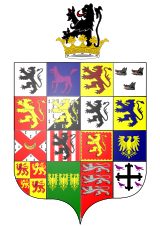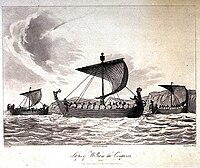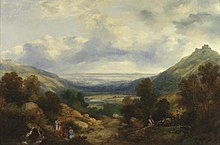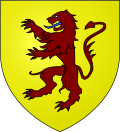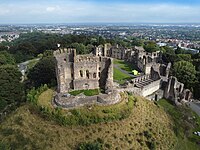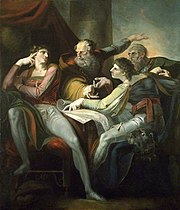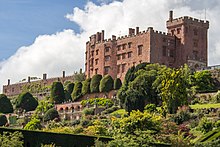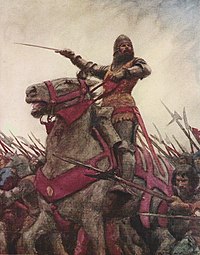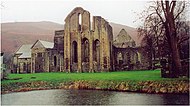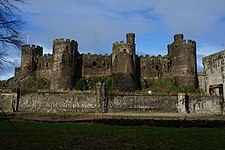
The Kingdom of Gwynedd was a Welsh kingdom and a Roman Empire successor state that emerged in sub-Roman Britain in the 5th century during the Anglo-Saxon settlement of Britain.

The Kingdom of Powys was a Welsh successor state, petty kingdom and principality that emerged during the Middle Ages following the end of Roman rule in Britain. It very roughly covered the northern two-thirds of the modern county of Powys and part of today's English West Midlands. More precisely, and based on the Romano-British tribal lands of the Ordovices in the west and the Cornovii in the east, its boundaries originally extended from the Cambrian Mountains in the west to include the modern West Midlands region of England in the east. The fertile river valleys of the Severn and Tern are found here, and this region is referred to in later Welsh literature as "the Paradise of Powys".

Rhys ap Tewdwr was a king of Deheubarth in Wales and member of the Dinefwr dynasty, a branch descended from Rhodri the Great. Following the Norman Conquest, he had to pay William the Conqueror to keep his kingdom, which lasted until the end of William's reign.

Bleddyn ap Cynfyn, sometimes spelled Blethyn, was an 11th-century Welsh king. King Harold Godwinson and Tostig Godwinson installed him and his brother, Rhiwallon, as the co-rulers of Gwynedd on his father's death in 1063, during their destruction of the kingdom of their half-brother, king Gruffydd ap Llywelyn. Bleddyn became king of Powys and co-ruler of the Kingdom of Gwynedd with his brother Rhiwallon from 1063 to 1075. His descendants continued to rule Powys as the House of Mathrafal.

Powys Fadog was the northern portion of the former princely realm of Powys. The princes of Powys Fadog would build their royal seat at Castell Dinas Brân, and their religious center at Valle Crucis Abbey. Some of its lordships included those of Maelor, Mochnant, Glyndyfrdwy, Yale, and Bromfield and Yale. Following the division of Powys, their cousin branch, the princes of Powys Wenwynwyn, would build Powis Castle.

Gruffydd Maelor was Prince of Powys Fadog in Wales. He is known as Gruffydd Maelor I to distinguish him from his grandson, Gruffydd Maelor II, Lord of Dinas Bran.
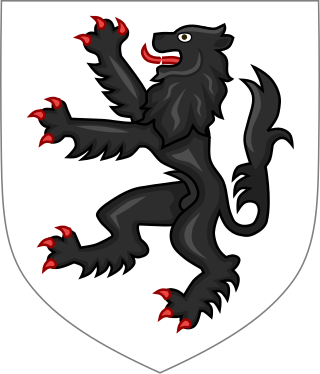
Madog ap Gruffudd, or Madog ap Gruffudd Maelor, was Prince of Powys Fadog from 1191 to 1236 in north-east Wales, and Lord of Powys. He was the founder of Valle Crucis Abbey in the Lordship of Yale.

Gruffudd Fychan II was Lord of Glyndyfrdwy and Lord of Cynllaith Owain c.1330–1369. As such, he had a claim to be hereditary Prince of Powys Fadog, and was a member of the Royal House of Mathrafal. His son, Owain Glyndwr, started the Welsh Revolt and became Prince of Wales.
Heraldry in Wales has a tradition distinct from that of English and Scottish heraldry. There is evidence that heraldry was already being used in Wales by the middle of the thirteenth century; for instance, in Gwynedd, two sons of Llywelyn the Great are recorded as having borne coats of arms in this period. Following the integration of Wales into England in the fourteenth and fifteenth centuries, the Welsh heraldic tradition became merged into that of England.

The Royal House of Dinefwr was a cadet branch of the Royal House of Gwynedd, founded by King Cadell ap Rhodri, son of Rhodri the Great. Their ancestor, Cunedda Wledig, born in late Roman Britain, was a Sub-Roman warlord who founded the Kingdom of Gwynedd during the 5th century, following the Anglo-Saxon settlement of Britain. As Celtic Britons, the House of Dinefwr was ruling before the Norman conquest, having to fight with their neighbors such as the Celtics, Anglo-Saxons and Vikings, before struggling with the Normans afterwards. Many members of this family were influential in Welsh history, such as Hywel Dda, who codified Welsh law under his rule, and achieved the important title of King of the Britons, or Lord Rhys, Prince of Wales, who rebelled against Richard the Lionheart, and became one of the most powerful Welsh leaders of the Middle ages.

Ial or Yale was a commote of medieval Wales within the cantref of Maelor in the Kingdom of Powys. When the Kingdom was divided in 1160, Maelor became part of the Princely realm of Powys Fadog, and belonged to the Royal House of Mathrafal. Yale eventually merged with another commote and became the Lordship of Bromfield and Yale, later a royal lordship under the Tudors and Stuarts.

The history of Gwynedd in the High Middle Ages is a period in the History of Wales spanning the 11th through the 13th centuries. Gwynedd, located in the north of Wales, eventually became the most dominant of Welsh polities during this period. Contact with continental courts allowed for Gwynedd to transition from a petty kingdom into an increasingly sophisticated principality of seasoned courtiers capable of high level deplomacy and representation; not only with the Angevine kings, but also the king of France and the Papal See. Distinctive achievements in Gwynedd include further development of Medieval Welsh literature, particularly poets known as the Beirdd y Tywysogion associated with the court of Gwynedd; the reformation of bardic schools; and the continued development of Cyfraith Hywel. All three of these further contributed to the development of a Welsh national identity in the face of Anglo-Norman encroachment of Wales.

Owain Brogyntyn ap Madog was prince of Powys and the third and illegitimate son of king Madog ap Maredudd, the last king of a united Kingdom of Powys. He was the son of Madog by the daughter of the Maer du or "black mayor" of Rûg in Edeyrnion however some sources cite his mother as Susanna making him legitimate instead. He was the brother of Gruffydd Maelor the ancestor of Owain Glyndŵr. Presumably Owain Brogyntyn would have been raised by his mother at Rûg in Edeyrnion. He was acknowledged by his father and granted by him the lordship of Edeyrnion and also Dinmael. It is quite possible that he inherited some of these lands through his maternal grandfather, the Maer Du, which were confirmed and perhaps extended by his father the king of Powys. At some point he also came into possession of Castle Brogyntyn on the English borders at Selattyn close to Oswestry.

The House of Aberffraw was a medieval royal court based in the village it was named after, Aberffraw, Anglesey within the borders of the then Kingdom of Gwynedd. The dynasty was founded in the 9th century by a King in Wales whose descendants founded the Welsh Royal Houses. The other medieval Welsh dynasties were the Royal Houses of Dinefwr, Mathrafal.

Tudur ap Gruffudd (1365–1405), also known as Tudor de Glendore or Tudor Glendower, was the Lord of Gwyddelwern, a junior title of the princely house of Powys Fadog, and was the younger brother of Owain Glyndŵr, the Welsh rebel leader crowned Prince of Wales. His father was Gruffydd Fychan II, the hereditary Prince of Powys Fadog and previous Lord of Gwyddelwern. Along with his brother, Owain Glyndŵr, Tudur was a member of the royal House of Mathrafal.
Sir Gruffydd Fychan ap Iorwerth Goch was a medieval Welsh Knight and Marcher Lord.

Ellis ap Griffith or Elissau ap Gruffudd, was the Baron of Gwyddelwern in Denbighshire, Wales, and the grandnephew of Owen Glendower, Prince of Wales. Following his family defeat during the Glyndwr Rising, his branch inherited the co-representation of the Royal House of Mathrafal, and were immortalized by William Shakespeare in the history play Henry IV. Through his mother Lowrie, he inherited the lordship of his grandfather, Tudor Glendower, and by marriage, the estate of Plas-yn-Yale. By this union, he became the founder of the House of Yale, represented by the Yale family, later known in America as the benefactors of Yale University.
